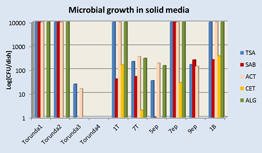Studies the nature and growth of micro- and macro-organisms on bio-deteriorated materials.
dating
morphology
technology
origin
composition
alteration

Ceramic

Glass

Metal

Mortar

Pigments

Stone

Wood
Ceramic Building Materials (CBM),Glass, Metals & Alloys, Mortar & Plaster, Stone, Pigments, Wood
Biological cultures aim at studying the nature and growth-pattern of biodeteriogens growing on historic building materials and monitoring the factors that encourage colonization, which include temperature, rain, shadow, sun, organic/inorganic pollutants, bioreceptivity* of the colonized material, etc. Moreover, the method is useful in order to estimate whether and how they are responsible for a material’s damage, to develop a sequence that aims at recovering the structural “health” of a building material preventing further decay, to evaluate the effi cacy of biocides* and to facilitate long-term monitoring treated materials.

Table and diagram of colony-forming unit (CFU) per petri dish. Biodeterioration analysis in the Fuente Nuevaof Martos (Jaen) within te Martos Porject 2012 (DIADRASIS)
Biological cultures allow the identification of the nature and observe the growth-pattern of micro- and macro-organisms in order to defi ne the type and degree of microbially induced damage.(Micro) Biological culture is the procedure consisting of reproducible growth of microbial cultures in defined physical and chemical environmental conditions.
accuracy
time
cost
in situ
invasive
destructive
There are several different types of growth media, generally containing a mixture of sugars and complex polysaccharides, carbohydrates, proteins, amino acids, lipids, water, urea, salts, trace elements (e.g. Iron, Copper, Magnesium, Potassium), vitamins, etc. In order to identify and characterize microbial species, it is necessary to obtain them in pure cultures, by spreading them out and permitting the individual cells to form colonies. Microbiological cultures are usually grown by means of two techniques:
N.B. For anaerobic microorganisms*, the atmosphere must be oxygen free.